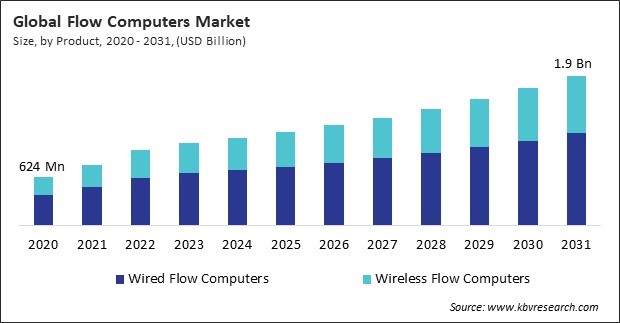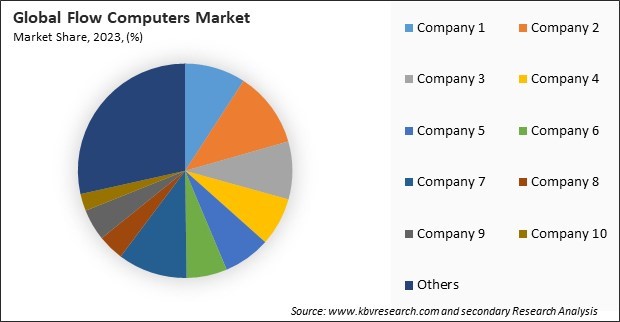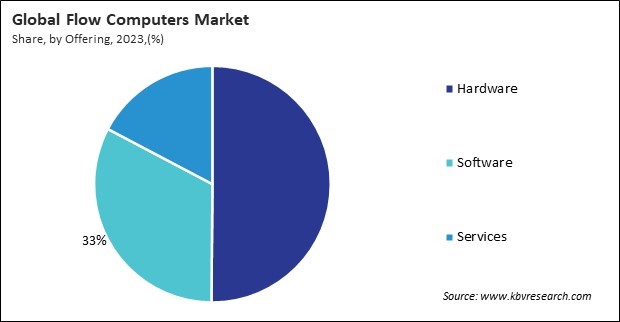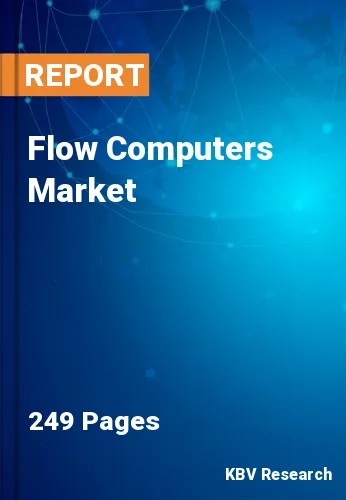“Global Flow Computers Market to reach a market value of 1.9 Billion by 2031 growing at a CAGR of 8%”
The Global Flow Computers Market size is expected to reach $1.9 billion by 2031, rising at a market growth of 8.0% CAGR during the forecast period.
The North America segment recorded 35% revenue share in this market in 2023. As a result of the substantial oil and gas industry in the region, which requires precise flow measurement for production, processing, and transportation, this dominance has been achieved. The United States, in particular, has seen significant investments in advanced flow measurement technologies, with companies relying on these computers to comply with stringent regulatory standards and improve operational efficiency.

These Modern computers are now integrated with sophisticated digital tools and automation systems, allowing for enhanced precision in measuring flow rates and volumes across various industries. The integration of digital technologies has allowed these computers to process an immense volume of data in real-time, providing highly precise flow measurements that are essential for industries. Even the slightest inaccuracies can result in substantial financial or operational losses. Hence, as industries continue to prioritize process optimization and resource efficiency, the demand for advanced computers with digital and automation capabilities is set to grow.
Additionally, Rapid urbanization and industrialization are significant trends reshaping global economies, particularly in developing regions such as Asia-Pacific and Africa. Urbanization is anticipated to increase to 68% by 2050, with over 55% of the global population presently residing in urban areas, as per UN-Habitat. This trend is especially evident in developing regions, where cities are expanding at an unprecedented pace. Thus, the combined forces of urbanization and industrialization create a fertile environment for this market.
However, these computers with advanced capabilities like multi-stream processing, real-time data analytics, and complex flow algorithms are integral to improving operational efficiency in industries like oil and gas, chemicals, and water treatment. However, the sophisticated technology embedded in these systems is expensive. The cost of purchasing, installing, and integrating these devices can be considerable, especially with specialized software, hardware upgrades, and ongoing maintenance. Consequently, the high adoption costs remain a significant roadblock to the growth of this market.

The leading players in the market are competing with diverse innovative offerings to remain competitive in the market. The above illustration shows the percentage of revenue shared by some of the leading companies in the market. The leading players of the market are adopting various strategies in order to cater demand coming from the different industries. The key developmental strategies in the market are Acquisitions, and Partnerships & Collaborations.
By end use, this market is divided into oil & gas, water & wastewater, energy & power generation, food & beverage, chemical, pulp & paper & metal & mining, and others. The energy & power generation segment garnered 20% revenue share in this market in 2023. The energy and power generation segment is driven by the global push for efficiency and sustainability in energy production. As countries transition toward renewable energy sources, there is an increasing need for advanced flow measurement technologies to optimize resource management, improve performance, and reduce emissions.
Based on offering, this market is classified into hardware, software, and services. The software segment procured 33% revenue share in this market in 2023. This expansion may be attributed to the increasing demand for sophisticated software solutions that improve data analysis, visualization, and integration capabilities. Software is essential for the optimization of flow computer performance, as it allows users to calibrate devices, analyze flow data, and ensure consistency with regulatory standards.

On the basis of product, this market is bifurcated into wired flow computers and wireless flow computers. The wireless flow computers segment recorded 37% revenue share in this market in 2023. Wireless flow computers offer several advantages, including ease of installation, reduced cabling costs, and the ability to monitor remote or hard-to-reach locations without extensive infrastructure modifications.
Free Valuable Insights: Global Flow Computers Market size to reach USD 1.9 Billion by 2031
Region-wise, this market is analyzed across North America, Europe, Asia Pacific, and LAMEA. The Europe segment witnessed 31% revenue share in this market in 2023. Europe's chemical and water management industries are particularly influential in this market as safety and emissions regulations continue to tighten. Countries like Germany and the United Kingdom have proactively implemented advanced flow measurement systems to ensure compliance with European Union directives.
| Report Attribute | Details |
|---|---|
| Market size value in 2023 | USD 1.1 Billion |
| Market size forecast in 2031 | USD 1.9 Billion |
| Base Year | 2023 |
| Historical Period | 2020 to 2022 |
| Forecast Period | 2024 to 2031 |
| Revenue Growth Rate | CAGR of 8.0% from 2024 to 2031 |
| Number of Pages | 249 |
| Tables | 380 |
| Report coverage | Market Trends, Revenue Estimation and Forecast, Segmentation Analysis, Regional and Country Breakdown, Market Share Analysis, Porter’s 5 Forces Analysis, Company Profiling, Companies Strategic Developments, SWOT Analysis, Winning Imperatives |
| Segments covered | Product, End Use, Offering, Region |
| Country scope |
|
| Companies Included | ABB Group, Schneider Electric SE, Emerson Electric Co., Yokogawa Electric Corporation, Thermo Fisher Scientific, Krohne Group, Honeywell International, Inc., Sika AG, Badger Meter, Inc., and Ametek, Inc. |
By Product
By End Use
By Offering
By Geography
This Market size is expected to reach $1.9 billion by 2031.
Advancements In Digital And Automation Technologies are driving the Market in coming years, however, High Initial Costs Associated With Flow Computers restraints the growth of the Market.
ABB Group, Schneider Electric SE, Emerson Electric Co., Yokogawa Electric Corporation, Thermo Fisher Scientific, Krohne Group, Honeywell International, Inc., Sika AG, Badger Meter, Inc., and Ametek, Inc.
The expected CAGR of this Market is 8.0% from 2024 to 2031.
The Oil & Gas segment led the maximum revenue in the Market by End Use in 2023, thereby, achieving a market value of $482.8 million by 2031.
The North America region dominated the Market by Region in 2023, and would continue to be a dominant market till 2031; thereby, achieving a market value of $659.9 million by 2031.
Our team of dedicated experts can provide you with attractive expansion opportunities for your business.

 Drivers
Drivers
 Restraints
Restraints
 Opportunities
Opportunities
 Challenges
Challenges
